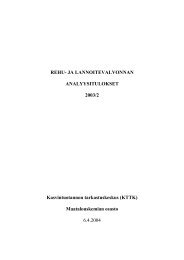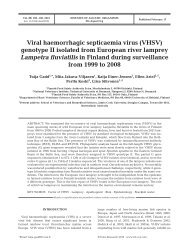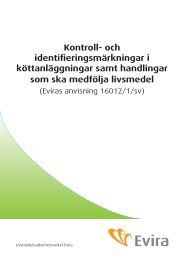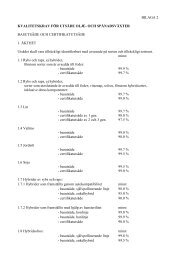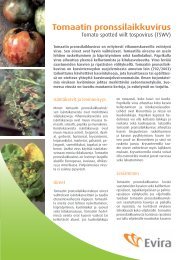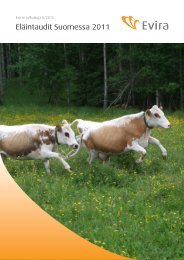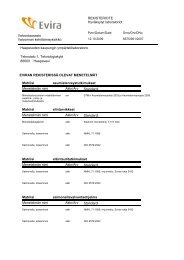Molecular characterization of endemic salmonella infections ... - Evira
Molecular characterization of endemic salmonella infections ... - Evira
Molecular characterization of endemic salmonella infections ... - Evira
You also want an ePaper? Increase the reach of your titles
YUMPU automatically turns print PDFs into web optimized ePapers that Google loves.
to replace phage typing in the future (Lan et al 2007). In a longitudinal study <strong>of</strong> 18 pig farms over a<br />
three-year period, AFLP differentiated between distinct clones within DT104. It was also more<br />
discriminatory than the PFGE and REP-PCR methods (Gebreyes et al 2006). In a study on S.<br />
Typhimurium comparing three PCR-based methods, AFLP, PCR-phage typing and detection <strong>of</strong><br />
integrons, the highest discriminatory power was achieved with the use <strong>of</strong> AFLP (Mikasová et al<br />
2005).<br />
A single-enzyme approach (SAFLP) based on the use <strong>of</strong> only one restriction enzyme with a single<br />
adapter was used to fingerprint 30 strains <strong>of</strong> S. enterica belonging to 14 different serotypes.<br />
SAFLP was able to differentiate between the serotypes and also to differentiate between both the<br />
phage types and between individual strains. Another advantage <strong>of</strong> SAFLP, besides its specifity, is<br />
its reproducibility and speed. It is faster to perform than many other DNA-based methods (Peters<br />
and Threlfall 2001). Fluorescent AFLP (FAFLP) uses fluorescent dye-labeled PCR primers. It may<br />
provide important insights into the microepidemiology <strong>of</strong> different Salmonella serovars (Lawson et<br />
al 2004). FAFLP was applied to 46 isolates <strong>of</strong> S. Typhimurium, comprising nine phage types. This<br />
method is highly discriminatory and was capable <strong>of</strong> grouping most serovar Typhimurium isolates<br />
according to phage type (Hu et al 2002). In a study by Tamada et al (2001), S. Typhimurium<br />
strains were analysed by both fluorescent AFLP and PFGE; both methods were equally useful for<br />
epidemiological typing, though no data on the phage type was given. In a study on 97 strains <strong>of</strong> S.<br />
enterica subsp. enterica, FAFLP had a discriminatory capacity equal to that <strong>of</strong> PFGE (Lindstedt et<br />
al 2000). In another study, FAFLP showed a greater ability than PFGE to discriminate between<br />
outbreak-associated and epidemiologically unrelated isolates <strong>of</strong> S. Typhimurium DT126. However,<br />
neither method was sufficiently sensitive to separate all epidemiologically unrelated DT126 isolates<br />
from the outbreak isolates (Ross and Heuzenroeder 2005a). When investigating an outbreak <strong>of</strong><br />
multiresistant S. Typhimurium DT104, the genotype <strong>of</strong> the outbreak-associated strain could not be<br />
differentiated from that found in most multiresistant DT104 isolates by either PFGE or fluorescent<br />
AFLP (Lawson et al 2004). When analysing 110 isolates and 25 serotypes <strong>of</strong> S. enterica<br />
subspecies enterica with multilocus sequence typing (MLST), PFGE and AFLP, it was concluded<br />
that with the MLST scheme used, PFGE and AFLP had a higher discriminatory power. It was<br />
suggested that AFLP should be used for local outbreak investigations, as the interpretation <strong>of</strong> the<br />
AFLP fingerprints was very subjective and dependent on the person performing both the analysis<br />
and the interpretation (Torpdahl et al 2005).<br />
IS200-PCR<br />
IS200-PCR is a procedure for the amplification <strong>of</strong> DNA fragments with outward-facing primers<br />
complementary to each end <strong>of</strong> the insertion sequence IS200. The method was evaluated and<br />
compared with other molecular methods such as ribotyping, RAPD analysis, ERIC-PCR and PCR<br />
35



